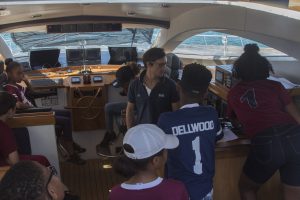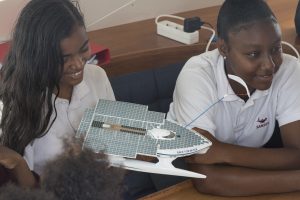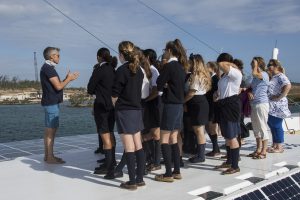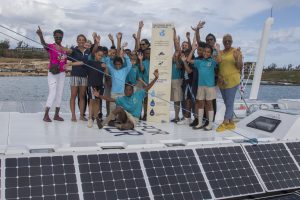For the past two weeks, the daily schedule on board Race for Water has centered around giving tours for children from the local schools. The students—ages eight to 18—have been touring Race for Water’s on-board exhibits, taking a walk on the solar-panel deck and getting to know the crew. The whole experience is an exercise in raising young people’s awareness about ocean preservation on a large scale, and the crew have been thrilled to pitch in.
“It’s big! Like a spaceship!” As the students waited in line on the dock, they got a chance to admire Race for Water before boarding. First Mate Annabelle Boudinot then gave them a “Welcome aboard!” in her new role as the ship’s tour guide. Once the students filed onto the gangway, there was absolutely no pushing and shoving; everyone had to watch their step and make sure not to fall. As the students explored their new environment, they were clearly mesmerized by what they saw. Up on deck, everyone rushed to welcome the new arrivals: Anne was already there with another class, giving tours one after another!
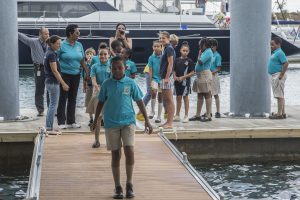
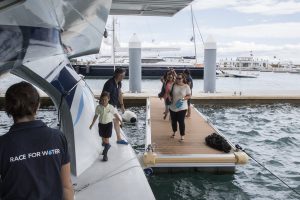
“Here we are in the ship’s mess hall, which is our main living area on board,” Annabelle explained. As the students took a close look around the room, they saw that the wood-paneled walls were covered with posters about Race for Water’s on-board systems and the Race for Water Foundation’s vision to fight plastics pollution. Annabelle gave a big smile and launched into her presentation, as the kids looked on in amazement. She then had the students pass a jar full of micro-plastics around, and told them, “This little jar holds all of the micro-plastics that we collected from a square of sand that measured just 25 centimeters on each side.” The students were able to look at samples of macro-plastics in another container. Annabelle then showed them the tooth marks on those pieces of plastic, sad evidence that animals had eaten them: “Every sea turtle has plastic in its stomach. We want the children to leave with an awareness that plastics pollution is truly a disaster for marine life,” Annabelle reported.
To solve the problem of plastics pollution, we must take action here on land, before the plastics get into the oceans. When we explain to children that there are different types of plastic, that plastic isn’t biodegradable and that it pollutes the ocean for a very, very long time, the students understand the importance of preserving the oceans around them. But, as Annabelle says, “We talk to them about solutions, and we explain the everyday actions that they can take to prevent plastics pollution.”
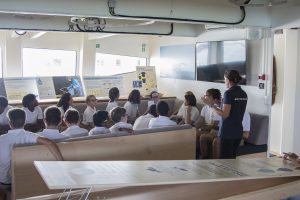
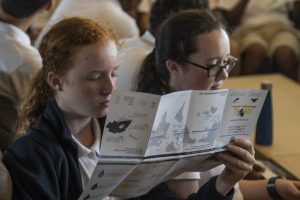
F R O M W O R D S T O A C T I O N
After they’re done with the exhibit and Annabelle’s presentation, the students tour Race for Water. “My cabin is on the port side, the storeroom is on the starboard side, and that’s where the scientists store their equipment,” Annabelle tells them. The students have tons of questions: “What do you do for food? And what about your families? Do you ever get to see them again?” After walking through the cockpit crammed with navigational instruments, the students get to experience the deck covered with solar panels. “You can even walk on top of them!” one student is amused to note. After their theory lesson, the students come face-to-face with reality: without sunshine, the panels don’t produce electricity and Race for Water can’t go anywhere. Annabelle tells them, “That’s why we added another on-board energy source—our wind-powered kite.” The students’ questions get more technical, but they have an easier time understanding the answers now that they’ve seen Race for Water for themselves. “Why can’t you use both kites at once? What do you have to do to be a part of the crew, do you take interns?” Engineer Martin Gavériaux joins the tour to answer their questions. He tells us, “I explain that even as crew members, we’re still learning how to manage the mix of energy sources!” The most important thing is this—the students understand that right now, it’s possible to live on board a ship and to sail around the world using only renewable energy.
